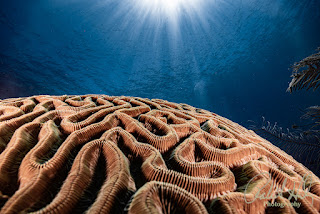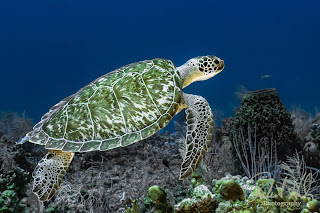Natural Light vs. Strobes in Underwater Photography: Which is Right for Your Shot?

When capturing stunning images underwater, deciding between natural lighting and strobes to illuminate your shots is crucial. Each method presents distinct benefits and hurdles. Discerning the best situations for each and understanding how to leverage them can significantly elevate your photographs' quality and visual appeal.
Let's examine each form of lighting in depth and consider its advantages and disadvantages. I also include some examples of what I have found to be good and bad shots to use.
The Beauty and Limitations of Natural Light
Advantages:
- Authentic
Look and Feel: Natural light captures the underwater world as it truly
is. The soft, ambient light gives your photos a more organic and realistic
look, particularly in shallow waters where sunlight can penetrate
effectively.
- Freedom
and Mobility: You can move more freely and efficiently in the water without additional lighting equipment. This is especially useful
when shooting in tight spaces or when you need to react quickly to
fast-moving subjects.
- Less
Equipment Hassle: Shooting with natural light simplifies your gear
setup. You don’t have to worry about the extra weight, battery management,
or strobe positioning, allowing you to focus more on your composition and
the moment.
- Wide-Angle
Shots: Natural light is adequate for wide-angle shots, which capture expansive seascapes, schools of fish, or
large marine creatures like sharks or manta rays. The even illumination
across the frame can highlight the grandeur of these subjects.
Challenges:
- Color
Loss: As you descend, water absorbs light, with red disappearing
first, followed by orange and yellow. This color loss can make your images
appear flat and washed out, especially at depths beyond 10 meters (33
feet).
- Limited
Depth: Natural light diminishes rapidly with depth. Below a certain
point, usually around 10 meters, the available light is insufficient to
capture detailed, vibrant images without pushing your camera’s settings to
the limit.
- Inconsistent
Lighting: Natural light is unpredictable. Factors like time of day,
water clarity, and weather conditions can significantly affect the quality of
light, making it difficult to achieve consistent results.
Best Uses for Natural Light:
- Shallow
Water Seascapes: Scenes in shallow waters, where sunlight can reach
and illuminate the entire environment, are ideal for natural light
photography. Examples include coral reefs bathed in sunlight or a school
of fish gliding through sunbeams.
- Snell’s
Window: Capturing the circular view of the surface from below, known
as Snell’s Window, is a beautiful application of natural light that
highlights the interplay between water and sunlight.
- Sunbeams
in Shallow Water: Imagine a school of fish swimming through a sunbeam
in a coral lagoon. The light creates dramatic patterns, highlighting the
scene’s natural beauty.
- Large
Pelagic Species: Capturing a whale shark or a manta ray in open water,
with the sun illuminating the entire frame, creates a majestic, almost
ethereal effect that showcases the ocean's vastness.
Worst Uses for Natural Light:
- Macro
Photography: In darker environments, bringing out the vibrant colors and fine details of tiny subjects like nudibranchs or shrimp is nearly impossible without artificial lighting.
- Deep
Dives: At depths greater than 20 meters (66 feet), natural light
becomes scarce, leading to dull, colorless images that lack contrast and
vibrancy.
The Power and Complexity of Strobes
Advantages:
- Restoring
Color: Strobes are essential for returning the vivid colors lost as you dive deeper. By providing a burst of light close to your
subject, you can reveal the true colors of the underwater world, from the
reds of coral to the yellows of fish.
- Controlled
Lighting: Strobes allow you to precisely control light's direction, intensity, and quality. This is particularly useful in macro
photography, where you need to highlight specific details without casting
harsh shadows.
- Versatility
Across Depths: Unlike natural light, strobes provide consistent
illumination at any depth, enabling you to capture clear, colorful images
even in deep or dark environments.
Challenges:
- Complex
Setup: Using strobes adds complexity to your dive setup. Positioning,
adjusting power levels, and managing multiple strobes can be challenging,
especially for beginners or in dynamic shooting environments.
- Backscatter:
In waters with a lot of particulate matter, strobes can cause
backscatter—small, bright spots in your image caused by light reflecting
off particles in the water. This can ruin an otherwise perfect shot.
- Bulky
Equipment: Strobes and their associated gear can be cumbersome, making
it more challenging to maneuver and maintain buoyancy, especially in strong
currents or confined spaces.
- Battery
Dependence: Strobes rely on batteries, which can be a limiting factor
during long dives or remote expeditions. You’ll need to monitor your
battery levels closely and carry spares, adding to your equipment load.
Best Uses for Strobes:
- Macro
Photography: Strobes excel in macro photography, allowing you to
capture stunning detail and color in minor subjects, like the iridescent
patterns on a tiny nudibranch or the intricate textures of a coral.
- Night
Dives: Strobes are indispensable during night dives. They illuminate the nocturnal creatures that emerge after dark, such as hunting octopuses or bioluminescent plankton, with stunning clarity.
- Wide-Angle
Scenes in Clear Water: With little backscatter and low turbidity,
wide-angle shots allow you to highlight the foreground or subject and let
the natural light fill in the rest of the shot.
Worst Uses for Strobes:
- Wide-Angle
Scenes in Murky Water: When shooting wide-angle scenes in water with
low visibility, strobes can cause severe backscatter, turning your shot
into a speckled mess.
- Fast-Moving
Subjects: If you’re trying to capture fast-moving subjects like
dolphins or sharks, strobes can sometimes fail to keep up, leading to
uneven lighting or missed shots. Also, Attempting to light significant
subjects like whales or sharks with strobes can lead to uneven lighting,
with parts of the subject well-lit and others in shadow. Natural light is
often more effective for these expansive scenes.
Which Should You Choose?
The choice between natural light and strobes ultimately
depends on your subject, the conditions, and the mood you want to create.
Natural light is ideal for wide-angle shots in shallow, clear water, offering a
more authentic and less equipment-intensive experience. On the other hand,
strobes are indispensable when you need to restore color, control light, or
shoot in deep or low-light environments.
As with any aspect of photography, practice and
experimentation are key. Spend time mastering both techniques and don’t be
afraid to switch between them depending on the situation. By understanding the
strengths and limitations of natural light and strobes, you’ll be better
equipped to capture the breathtaking beauty of the underwater world in all its
forms.
Stay Connected
Follow my blog for more tips and tutorials on underwater photography. Let's dive deeper into the art and craft of capturing the marine world!
Subscribe to my blog for more tips and tutorials on underwater photography. Don’t forget to share your processed photos on social media using the hashtag #RobertHerbPhotography. I look forward to reviewing your results.
New Online Training Program
I am excited to announce that I am creating an online training program to teach underwater hobbyists and enthusiasts how to enhance their photos using Adobe Lightroom. If you are interested in this training or need more information, please contact me at bob@robertherb.com to express your interest and to be notified about the details and start date of the classes.
Stay tuned and "Follow" for upcoming blogs on underwater photography tips and tricks for more in-depth insights. Please leave your comments and suggestions. Enjoy your diving and shooting experience!
I am eagerly anticipating your valuable feedback and suggestions.
Sincerely,
Bob Herb
|
|




Comments
Post a Comment
Please let me know your comments.